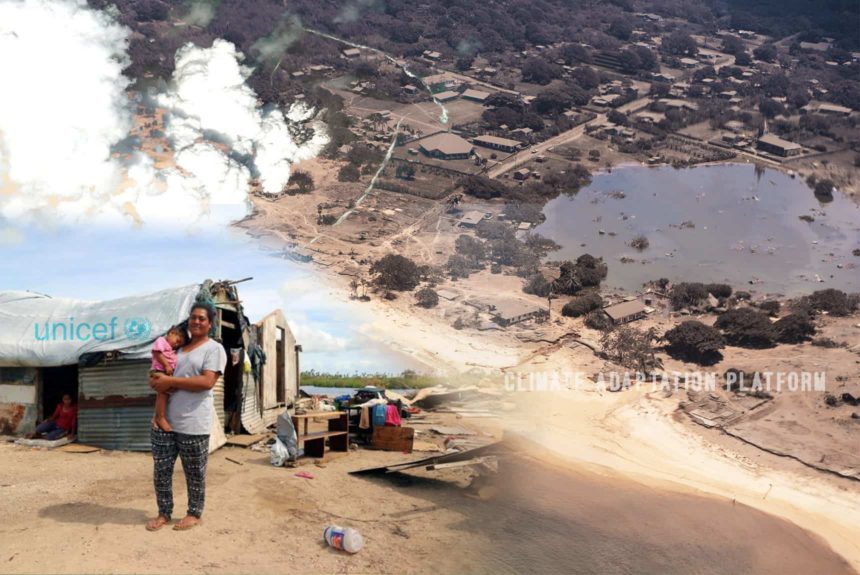Tongans are still recovering from the devastation from the January 15 underground volcanic eruption. Nova reports that 84% of the nation’s residents are affected by the 300-mile ash cloud from the explosion and the tsunami (Noron, 2022).
Residents find it hard to access safe drinking water and groundwater. The agricultural sectors consisting of crops, livestock, and fisheries suffered significantly, and 60-70% of households have lost animals, their land damaged, and contaminated their water sources.
On Nomuka island, volcanic ash blanketed all their structures, many of which were damaged and destroyed.
After the clean-up has been finished, the country will focus on rebuilding or building a more robust and more resilient infrastructure that could withstand future disasters.
The Sendai Framework for Disaster Risk Reduction advocates for a “The substantial reduction of disaster risk and losses in lives, livelihoods, and health and in the economic, physical, social, cultural and environmental assets of persons, businesses, communities, and countries.”
But apart from the Sendai Framework, Tonga can learn from Fiji’s rebuilding efforts after Cyclone Winston hit the country in 2016.
The category 5 cyclone-affected more than half of the population, destroying thousands of homes leaving hundreds of thousands of Fijians homeless, representing 22% of its total households.
Like Tonga, Fiji suffered from widespread power and infrastructure and communications destruction.
A research team from New Zealand documented Fiji’s reconstruction of its houses. What these documents reveal can serve as valuable lessons for Tonga.
According to The Conversation, there were two sets of house-rebuilding efforts in Fiji. One is through the government program, and the second is through the various international and local NGOs sponsors (Wilkinson, 2022).
Both initiatives have their strengths and weaknesses and elicit community reactions.
The government initiative, Help for Homes, allows communities to choose a design for a basic dwelling and its materials. It also provided information on building standards and best practices but lacked technical or practical support.
While it gives the community autonomy to decide what their home should look like, the lack of local building skills leads to poorly built houses, and the high costs of materials due to limited supplies lead to partially built homes.
On the other hand, the NGO’s housing initiative employs skilled workers to construct and supervise the building of the houses with the help of community labour.
These houses were largely standardized and more resilient to future disasters. The only feedback from homeowners is that they do not have sufficient input into the design of their homes.
This careful and thorough documentation of Fiji’s housing rebuild offers four key lessons:
- ensure that the initial assessment process is thorough and up to international standards,
- recognition that overall housing stock needs to improve and commit to higher standards,
- local architecture and building practices should be disaster-resilient, and
- combine the strengths of both government and NGO’s led housing programs to maximize community involvement.
Climate change reports warn that small island developing states (SIDS) will continue to experience extreme natural events, one that will increase in severity and frequency.
Building climate-resilient homes, buildings, and infrastructure will enable these communities to adapt to climate change and natural disasters.
Sources:
Noron, K. (2022, February 12). Why Tonga’s volcanic eruption was so destructive. Nova. Retrieved from https://www.pbs.org/wgbh/nova/article/hunga-tonga-volcano-eruption-education/
The 15 January 2022 eruption of Hunga Tonga-Hunga Haʻapai by Japan Meteorological Agency, CC BY 4.0, https://commons.wikimedia.org/w/index.php?curid=114666849
Wilkinson, S., Elkharboutly, M. & Potagaroa, R. (2022, February 4). Rebuilding post-eruption Tonga: 4 key lessons from Fiji after the devastation of Cyclone Winston. The Conversation. Retrieved from https://theconversation.com/rebuilding-post-eruption-tonga-4-key-lessons-from-fiji-after-the-devastation-of-cyclone-winston-175611



Leave a Reply